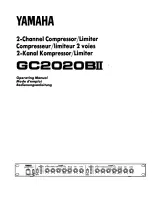
GB
9
f) Keep bystanders away. Children and bystanders should be kept away from the
compressor. Unintentional interaction with the compressor is dangerous.
g) Do not abuse cables and hoses. Keep cables and hoses from heat, fluids and sharp
edges. NEVER attempt to strain the cables and hoses further than their fully extended
reach, or allow them to become tangled.
h) The air compressor should be stored correctly and depressurised. During storage and
transportation the compressor should be free from pressure, ALWAYS expel the air from
the air compressor after use.
i) Ensure that the pressure rating is compliant with the tool. ALWAYS check the air tool has
a safety working pressure that exceeds the working pressure of the machine.
j) Use appropriate protection for the task at hand. Suitable protection for the application;
face masks will protect from spray paints and goggles will protect from flying debris.
k) Operate the air compressor correctly. Adhere to the operation instructions provided in
the manual. NEVER allow children or persons unfamiliar with the operation of the air
compressor use this product.
l) Disconnect accessories with care. Depressurise the tank and ensure that the air supply is
turned off prior to removing accessories and air tools.
m) Wear appropriate clothing. Loose hanging clothing, jewellery or long hair can be caught in
moving parts.
n) Keep the air compressor dry and free from moisture. Condensation can become trapped
within the system. A specified release valve will remove moisture from the air compressor.
o) Ensure the compressor is compliant with local rules and regulations. Regular testing will
determine whether the air compressor is suitable for service in certain regions.
p) Ensure lubrication levels are within specification (where applicable). Operating the air
compressor without sufficient lubrication will affect the longevity of the components.
q) Take the correct precautions when performing maintenance. Ensure ALL compressed air
is expelled from the air compressor tank and the power supply is disconnected before
commencing any maintenance procedures.
r) Operate air compressor within an appropriate environment. DO NOT use in ambient
temperatures below 0°C, wet, or damp conditions. ONLY indoor use is permitted for air
compressor operation.
s) Freezing of condensation within the system can damage components and create
potential for harm to the operator. This may be prevented by operating the air compressor
in suitable ambient temperatures, and by frequently expelling condensation from the
system.
270120_Z1MANPRO1.indd 9
22/07/2014 17:02










































